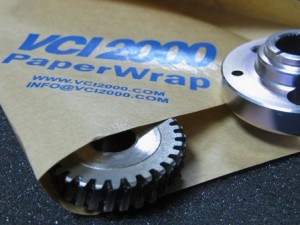Corrosion, the silent nemesis of metal assets, poses a constant threat to industries worldwide. From manufacturing plants to shipping containers, the battle against rust and corrosion is never-ending. In this blog post, we will explore the challenges posed by corrosion and introduce an innovative solution – VCI Bubble Bags.
I. The Corrosion Conundrum
Corrosion is a pervasive issue affecting various metal surfaces, leading to deterioration, structural damage, and financial losses. Understanding the causes and consequences of corrosion is crucial for industries seeking to protect their assets and ensure longevity.
1.1 The Culprits: Understanding Corrosion Agents
Corrosion, a relentless adversary to metal structures, is instigated by a multitude of agents. Unmasking these primary culprits is essential for comprehending the complexities of the corrosion conundrum and implementing effective preventive measures.
Moisture: The Silent Initiator
Moisture, in the form of humidity or water, stands as the chief provocateur of corrosion. Understanding how moisture infiltrates metal surfaces and reacts with different metals is paramount in devising strategies to combat its corrosive effects.
Oxygen: The Essential Corrosive Element
Oxygen, indispensable for life, paradoxically plays a detrimental role in the life cycle of metals. Delving into the chemical reactions that occur between oxygen and metal surfaces provides insights into the initiation and progression of corrosion.
Corrosive Gases: Hidden Threats
Certain atmospheric gases, such as sulfur dioxide and hydrogen sulfide, contribute significantly to corrosion. Unveiling the sources and understanding the mechanisms through which these corrosive gases accelerate the degradation of metals is crucial for effective preventive measures.
Salts and Chemicals: Accelerators of Decay
Exposure to salts and chemicals, whether from industrial processes or environmental sources, intensifies the corrosive impact on metal structures. Examining the specific reactions and corrosion patterns induced by these elements’ sheds light on their role as corrosion accelerators.
Microbial Corrosion: Nature’s Contribution
In some environments, microorganisms participate in the corrosion process. Exploring the types of microbes involved and the conditions conducive to microbial corrosion reveals a lesser known but significant aspect of the corrosion spectrum.
Galvanic Corrosion: The Electrochemical Tango
When dissimilar metals come into contact, galvanic corrosion can occur. Unraveling the electrochemical processes behind this phenomenon elucidates the challenges posed by mixed-metal environments and guides preventive measures.
II. VCI Technology: A Game-Changer
VCI technology emerges as a revolutionary solution in the battle against corrosion. This section delves into the science behind VCI and its effectiveness in safeguarding metal assets.
2.1 How VCI Works: Unraveling the Mechanism
Vapor Corrosion Inhibitors (VCIs) stand as a technological marvel in the realm of corrosion prevention. Understanding the intricate mechanism behind VCI technology is pivotal for appreciating its efficacy in forming a protective shield against the corrosive forces that threaten metal assets.
The Vapor Phase Action
VCIs operate in the vapor phase, leveraging the principles of chemistry to create an invisible, protective shield on metal surfaces. By releasing vapor molecules, VCIs disperse throughout the enclosed space, reaching even the most intricate and hard-to-reach areas of metal structures.
Adsorption on Metal Surfaces
As the vapor molecules make contact with metal surfaces, they adsorb onto the metal, forming a molecular barrier. This barrier impedes the interaction between the metal and corrosive elements, such as moisture, oxygen, and corrosive gases, effectively preventing the initiation and progression of corrosion.
Continuous Protection
One of the key advantages of VCI technology lies in its ability to provide continuous protection. The vapor molecules remain active for an extended period, ensuring that the protective layer persists even in dynamic and challenging environments.
Multi-Metal Compatibility
VCIs exhibit a remarkable feature of being compatible with various metals. This makes them versatile in diverse industrial applications where different metals coexist, mitigating the challenges posed by galvanic corrosion in mixed-metal environments.
III. Enter VCI Bubble Bags: A Protective Shield
VCI Bubble Bags combine the protective power of VCI technology with the practicality of bubble wrap. This section explores the features and benefits of using VCI Bubble Bags for corrosion prevention.
3.1 The Anatomy of VCI Bubble Bags
To truly appreciate the effectiveness of VCI Bubble Bags in corrosion prevention, it’s essential to delve into their design and construction. Understanding the intricacies of these innovative protective enclosures sheds light on how they create a formidable defense against the corrosive forces that threaten metal assets.
Outer Layer: Bubble Wrap Armor
The outer layer of VCI Bubble Bags comprises traditional bubble wrap, serving a dual purpose. Firstly, it provides physical protection against minor impacts, abrasions, and vibrations during storage, transit, or handling. Secondly, the bubble wrap acts as an insulating layer, helping to maintain a stable environment within the bag.
Inner Layer: Vapor Corrosion Inhibitors (VCIs)
The inner layer of VCI Bubble Bags is where the magic happens. Embedded within the walls of the bag are Vapor Corrosion Inhibitors (VCIs), typically in the form of special compounds or films. These VCIs are carefully formulated to release vapor molecules into the enclosed space, creating a protective atmosphere around the metal components.
Sealed Enclosure: Creating a Protective Bubble
The combination of the outer layer and inner VCI layer creates a sealed enclosure around the metal components. This sealed environment is crucial for ensuring that the VCIs can work effectively, dispersing evenly and adhering to metal surfaces to form a protective layer.
Self-Healing Properties
Some advanced VCI Bubble Bags incorporate self-healing properties into their design. If the bag is punctured or damaged during use, the self-healing features help maintain the integrity of the protective enclosure. This ensures that the corrosion prevention capabilities remain intact even in challenging conditions.
IV. Advantages of VCI Bubble Bags
This section delves into the specific advantages that make VCI Bubble Bags an ideal choice for corrosion protection.
4.1 Long-Term Protection: Preserving Assets with VCI Bubble Bags
In the relentless battle against corrosion, the need for solutions that go beyond mere surface protection becomes paramount. VCI Bubble Bags emerge as champions in this endeavor, offering extended protection that goes hand-in-hand with the preservation of valuable metal assets.
Encapsulation in a Protective Bubble
VCI Bubble Bags take the concept of corrosion protection a step further by encapsulating metal components in a double-layered defense. The outer layer consists of the familiar bubble wrap, offering physical protection against minor impacts and abrasions, while the inner layer contains the Vapor Corrosion Inhibitors (VCIs).
Sustained Vapor Phase Action
The key to VCI Bubble Bags’ effectiveness lies in their ability to maintain a sustained vapor phase action over an extended period. As the VCIs vaporize within the sealed enclosure, they create a protective atmosphere that envelops the metal surfaces, forming a molecular barrier against the corrosive agents identified earlier.
Prevention of Initial Corrosion Stages
By acting in the early stages of corrosion, VCI Bubble Bags prevent the initiation of rust and deterioration. This proactive approach is particularly crucial for assets in storage, during transit, or in intermittent use, where the risk of corrosion during dormant periods is high.
Adaptable to Various Environments
Whether in the confined spaces of storage units, shipping containers, or outdoor facilities exposed to the elements, VCI Bubble Bags prove adaptable to diverse environments. Their effectiveness is not compromised by variations in temperature, humidity, or atmospheric conditions, ensuring consistent protection.
Extended Shelf Life and Reduced Maintenance
The long-term protection offered by VCI Bubble Bags translates into extended shelf life for stored components. This, in turn, leads to reduced maintenance requirements and mitigates the financial burden associated with frequent inspections, repairs, and replacements.
Conclusion: A Corrosion-Free Future with VCI Bubble Bags
In conclusion, VCI Bubble Bags emerge as a formidable solution to the corrosion conundrum, offering industries a reliable and efficient method to protect their metal assets. As technology continues to advance, the battle against corrosion takes a significant leap forward with these innovative protective measures.






